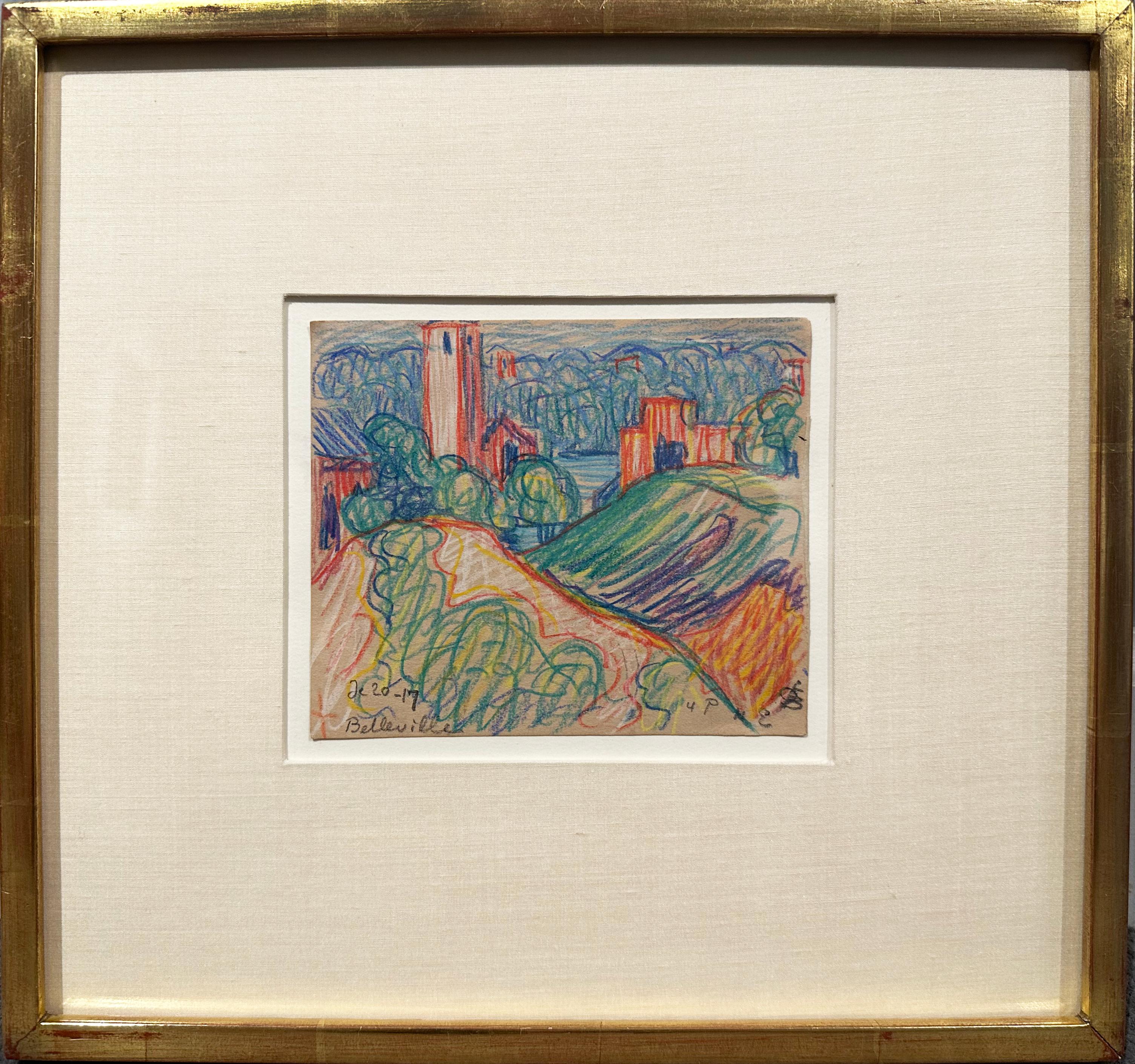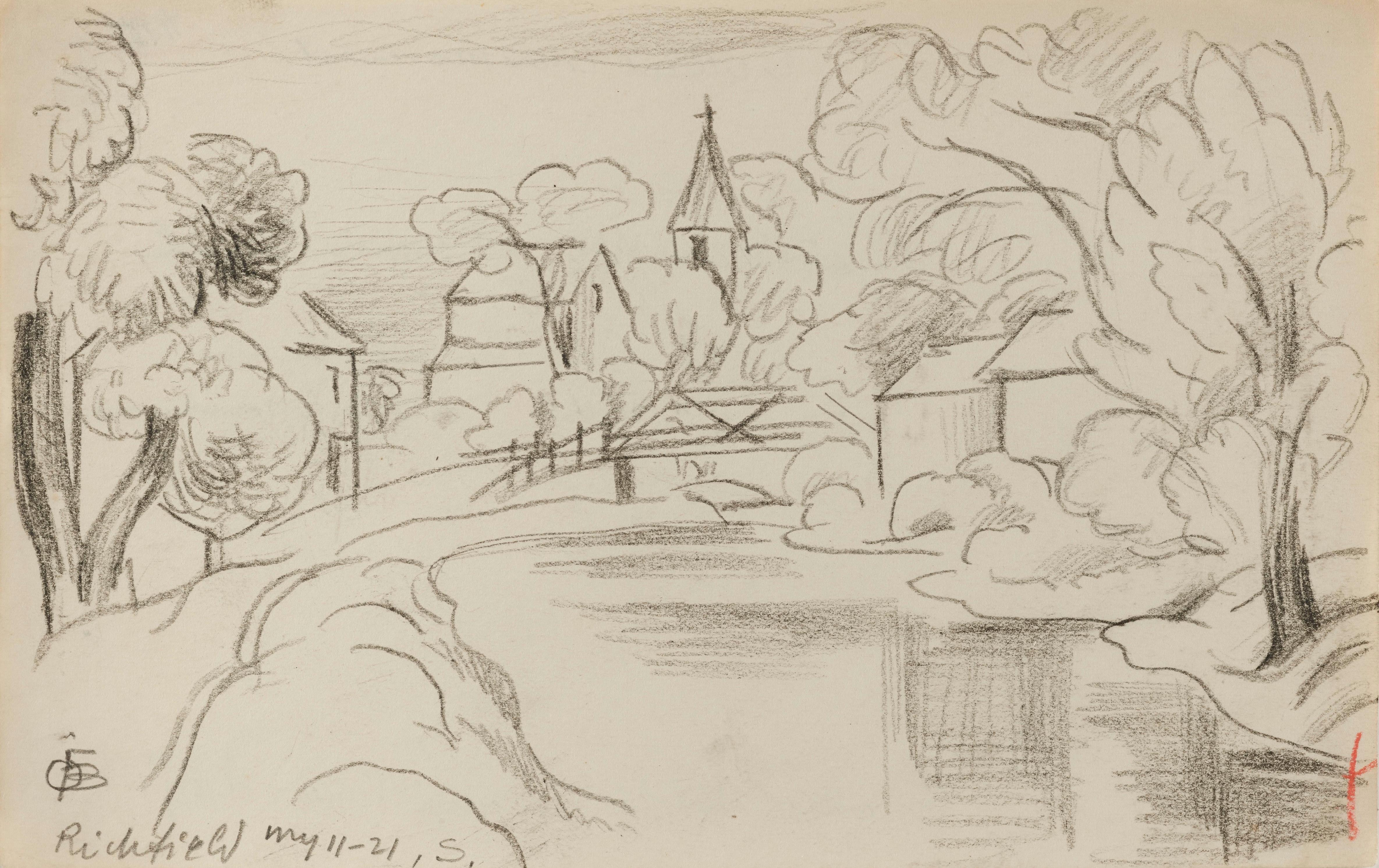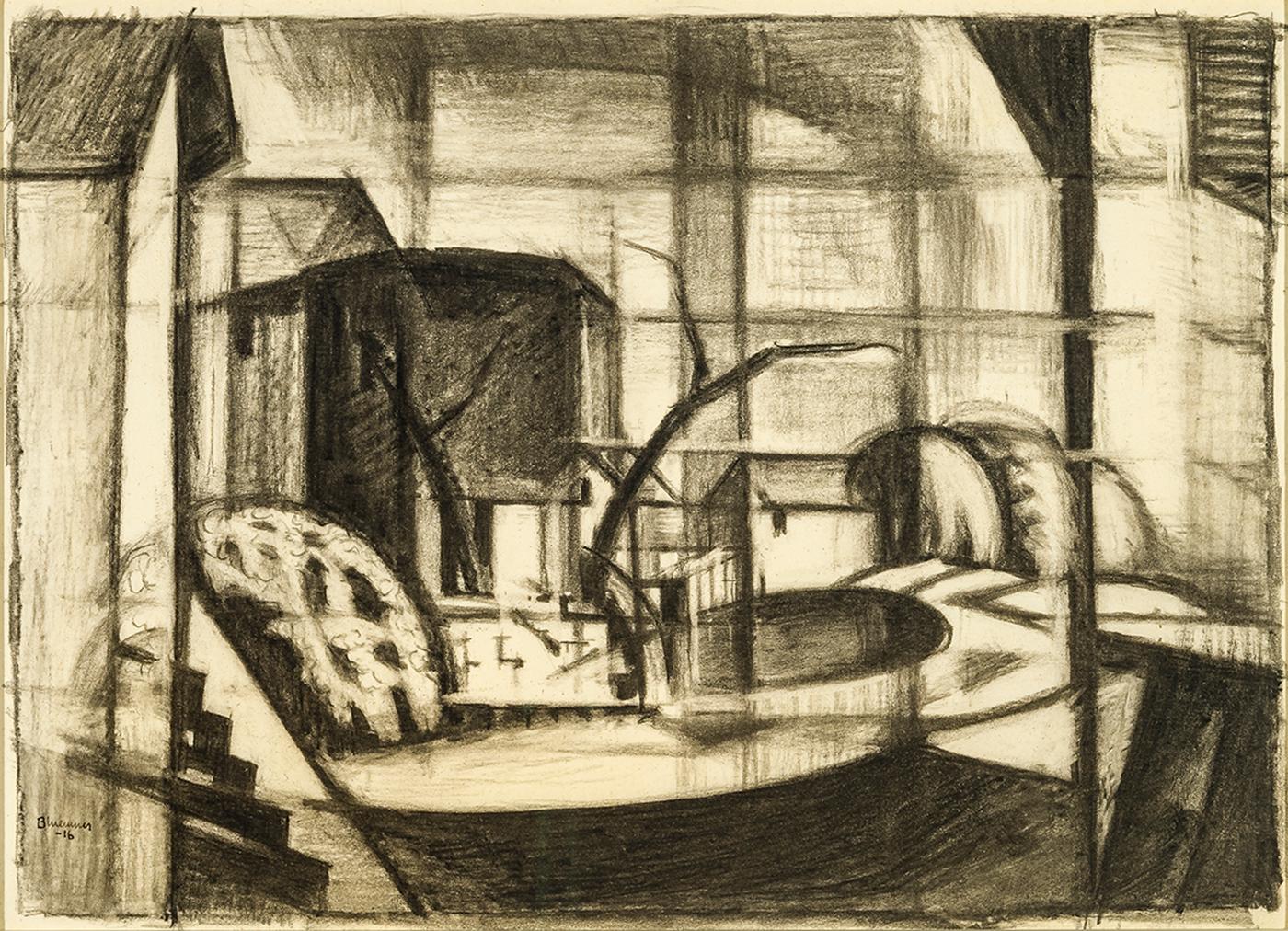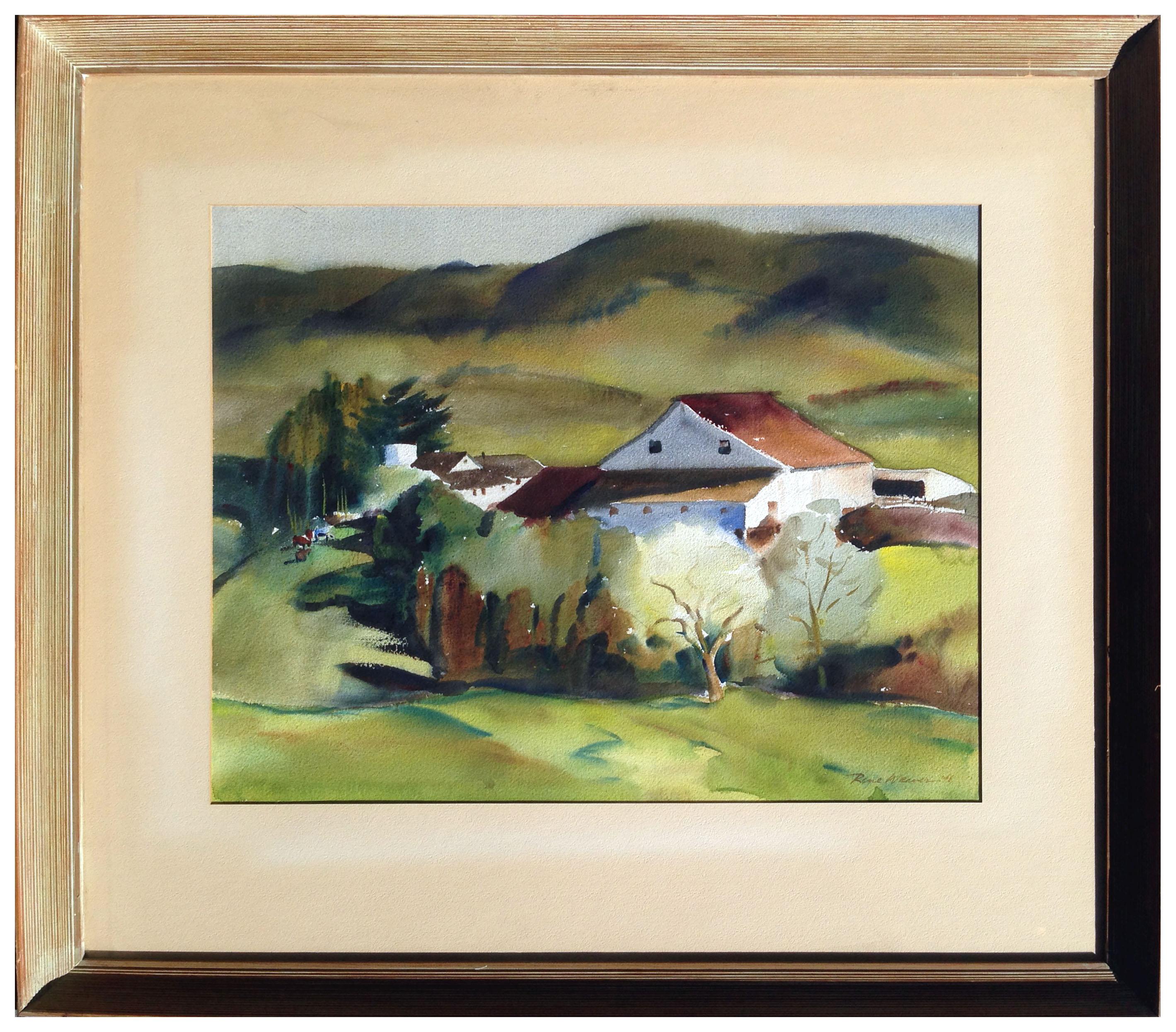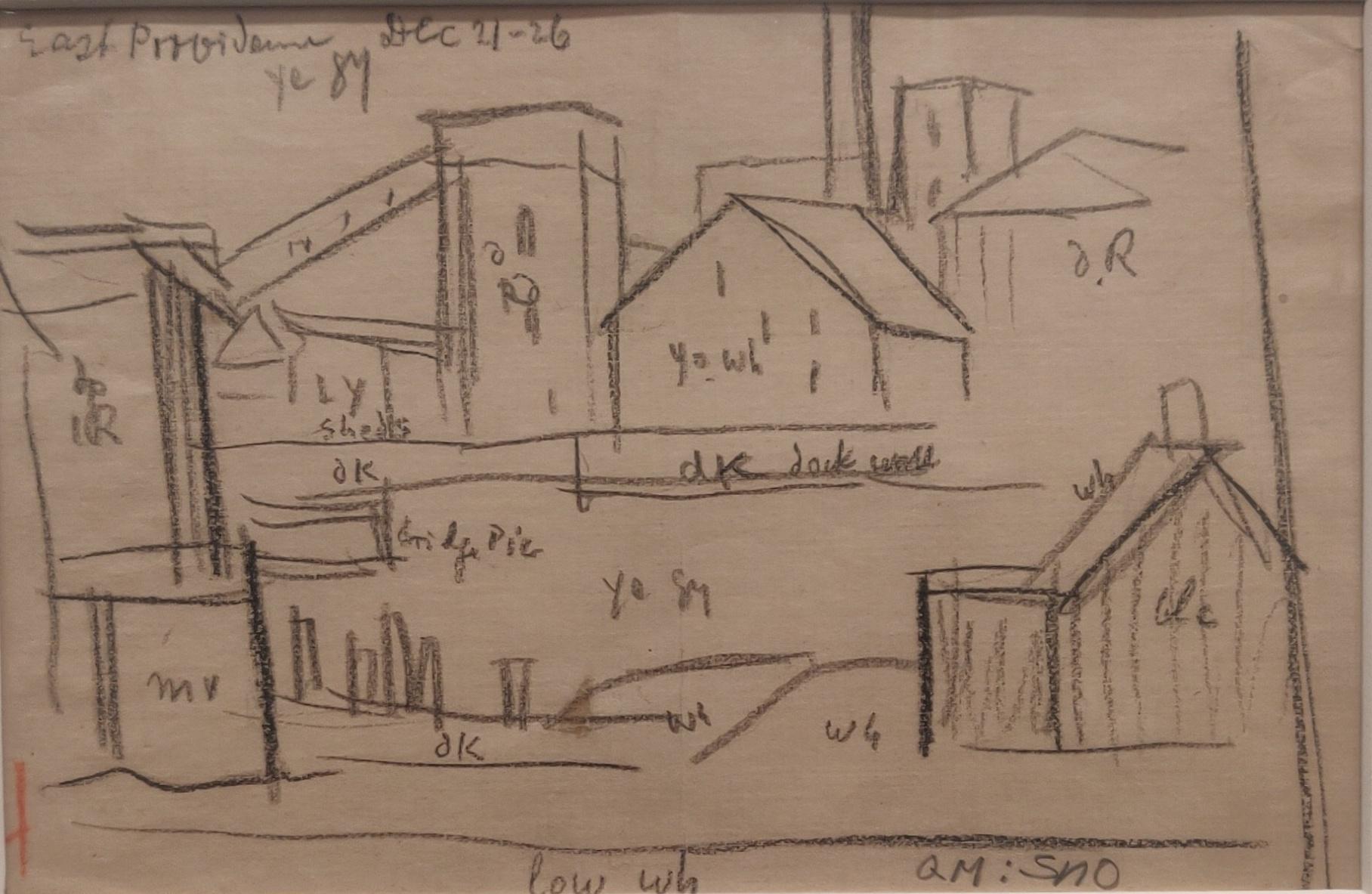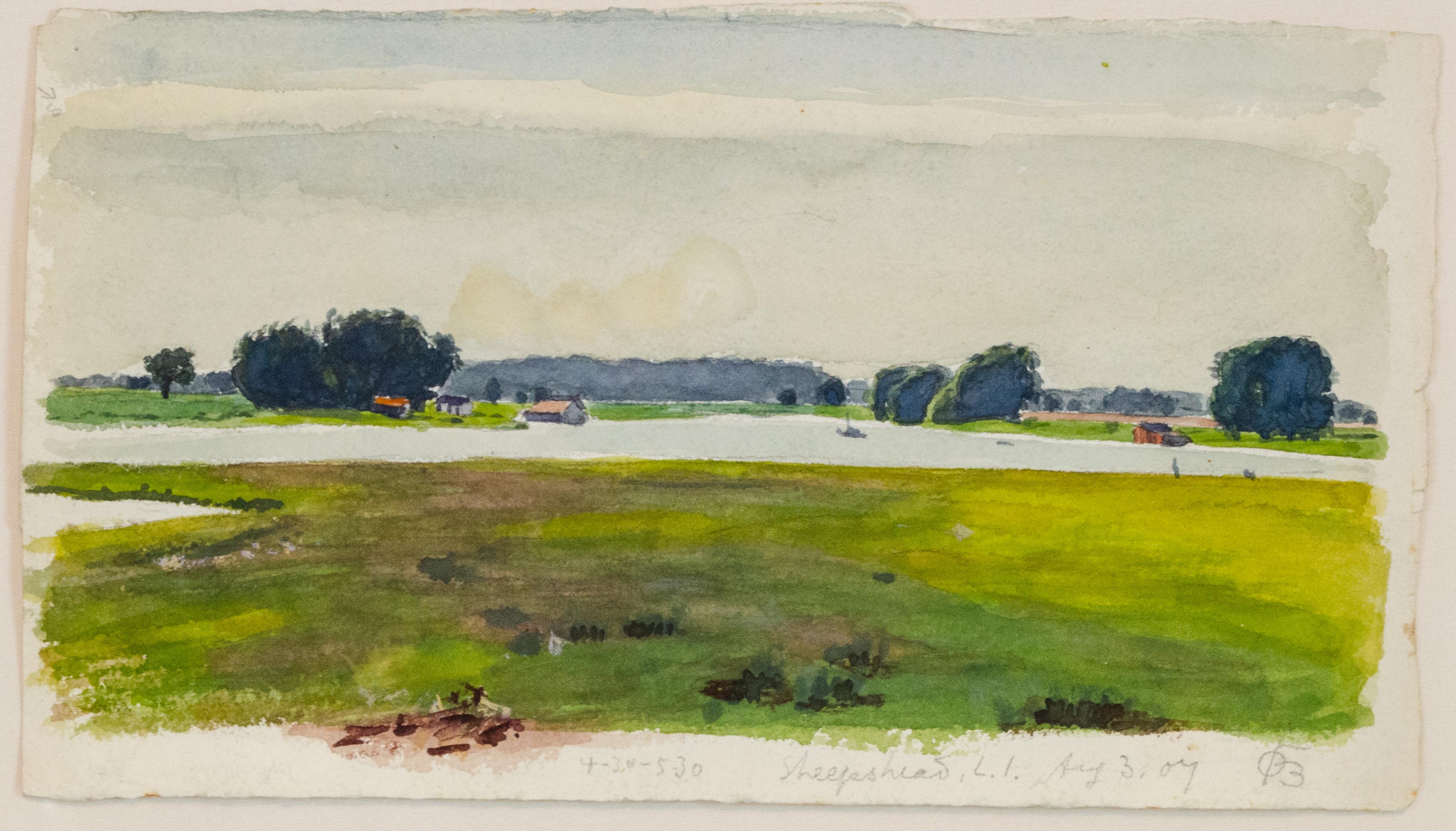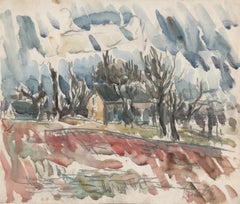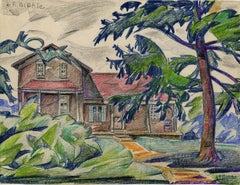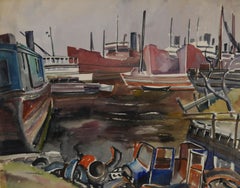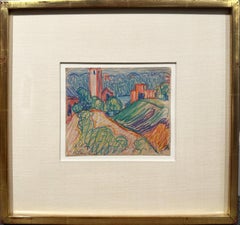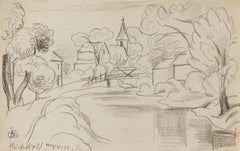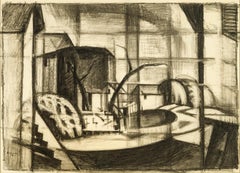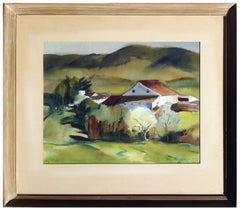Items Similar to Brookdale, New Jersey
Want more images or videos?
Request additional images or videos from the seller
1 of 7
Oscar Florianus BluemnerBrookdale, New Jersey1922
1922
$1,700
£1,307.75
€1,517.93
CA$2,397.41
A$2,685.50
CHF 1,410.52
MX$32,654.79
NOK 17,861.80
SEK 16,955.65
DKK 11,328.90
About the Item
Brookdale, New Jersey
Graphite on paper, 1922
Signed with the artist's initials l.l., and dated 1922 (see photo)
Annotated "Brookdale" front and back of sheet
Condition: Excellent
Archival framing with 8 ply acid free rag matting and UV filtering glass. Housed in a Marin style metal leaf, finished corner frame
Frame size: 15 x 16-3/8 x 3/4 inches
Image size: 5 x 6 3/4 inches
Provenance: Estate of the Artist
Courtesy of Wikipedia
Oscar Bluemner (June 21, 1867 – January 12, 1938), born Friedrich Julius Oskar Blümner and after 1933 known as Oscar Florianus Bluemner, was a Prussian-born American Modernist painter.
Early life
Bluemner was born as Friedrich Julius Oskar Blümner in Prenzlau, Kingdom of Prussia (now Germany), on June 21, 1867. He studied painting and architecture at the Royal School of Art in Berlin.
Architecture
Bluemner moved to Chicago in 1893 where he freelanced as a draftsman at the World's Columbian Exposition. After the exposition, he attempted to find work in Chicago. In 1901, he relocated to New York City where he also was unable to find steady employment. In 1903, he created the winning design for the Bronx Borough Courthouse in New York, although it is credited to Michael J. Garvin. The scandal that arose around this took down borough president Louis Haffen for corruption and fraud.
In 1908 Bluemner met Alfred Stieglitz, who introduced him to the artistic innovations of the European and American avant-garde. By 1910, Bluemner had decided to pursue painting full-time rather than architecture.
He exhibited in the 1913 Armory Show. He said that the Americans' contribution failed to match that of the Europeans because the American selection process reflected rivalries and compromises rather than curatorial judgment, resulting in a "melée of antagonistic examples".Then in 1915 Stieglitz gave him a solo exhibition at his gallery, 291. Despite participating in several exhibitions, including solo shows, for the next ten years Bluemner failed to sell many paintings and lived with his family in near poverty.
He created paintings for the Federal Arts Project in the 1930s.
Later life
After his wife's death in 1926, Bluemner moved to South Braintree, Massachusetts. From there in 1932 he contributed a letter to an ongoing debate in the New York Times on the question "What is American Art?". He wrote:
“America sells its shoes, machines, canned beef and so forth in Europe and all over the world not because they have an American style or are wrapped in the American flag, but simply because they are best. Thus also, the French export their paintings and birth-control, and the Germans export sauerkraut and prima donnas, because those things, each, are best. Today, for quality, nationalism, as a race-attribute, means nothing; chemistry, astronomy, or engineering admit, nowhere, of any national flavoring, nor do higher things like religion or philosophy.
Let us, here, make progressive and best painting, each one as he is fit to do, and merely ask: What and when is painting, in a critical sense? ... How can the people agree on what is American style, if the painters themselves, and by their work, disagree profoundly as to what real painting itself is! And there is, and always was, nothing more contemptible, ridiculous and, to art, disastrous, than patrioteering, which thinly veils profiteering.
Ideally, art, pure, is of a sphere and of no country; the first real artists, always and everywhere, have either been importers or immigrants bringing the light with them. El Greco, an immigrant ... defied the Spanish professors ... ; we, now, call his work more truly Spanish than that of his local contemporaries. And in the same sense, the future will not fail to stamp that of our own work as peculiarly American in which the living painter, here, has injected no conscious thought of his hailing from Hoboken or Kankakee, and every consideration of pure and modern painting and of the supreme quality he maybe capable of.”
He had a successful one-man show in 1935 at the Marie Harriman Gallery in New York City. In the New York Times, Edward Alden Jewell called it Bluemner's "apotheosis". He wrote:
He is very much alive and has been working of late ... with robustious [sic] results. These twenty-eight canvases bear the generic title , "New Landscape Paintings." That is because Mr. Blkuemner feels that some degree of "representation" is essential if abstract ideas are to be put over with entire success. However, the artist more fully and more exactly classifies them as "compositions for color themes." He might, if he chose, even call them "color music" without risking the opprobrium that usually attends excursions into so hazardous a field. ... These startling pictures build harmonies and rhythms that depend as a rule on simple statement. Here we find none of the overtones and undertones that some other artists have employed in projecting visual music. Bluemner relies for his effect upon plain, resonant chords. Though modulations of tone occur, these seem of secondary importance in his scheme. There is decidedly something in this new, bold, exclamatory style.
Bluemner died by suicide on January 12, 1938.
Legacy
Stetson University holds more than 1,000 pieces of Oscar Bluemner's work bequeathed in 1997 by his daughter, Vera Bluemner Kouba. In 2009 the Homer and Dolly Hand Art Center at Stetson opened with a primary mission of housing a providing exhibition space for the Kouba Collection. Often overlooked in his lifetime, Bluemner now is widely acknowledged as a key player in the creation of American artistic Modernism, with better-known colleagues such as Georgia O'Keeffe and John Marin.
In 2013, the Montclair Art Museum in New Jersey presented an exhibition of Bluemner's works depicting the landscapes and industrial areas of Paterson, painted between 1910 and 1917, drawn from the Stetson holdings. It marked the centenary of the Paterson silk strike, which had inspired his politics.
An oil painting by Bluemner, Illusion of a Prairie, New Jersey (Red Farm at Pochuck) (1915) sold at Christie's, New York, for $5,346,500 on November 30, 2011.
- Creator:Oscar Florianus Bluemner (1867-1938, American)
- Creation Year:1922
- Dimensions:Height: 5 in (12.7 cm)Width: 6.75 in (17.15 cm)
- Medium:
- Movement & Style:
- Period:
- Condition:
- Gallery Location:Fairlawn, OH
- Reference Number:Seller: FA37421stDibs: LU14016412952
About the Seller
5.0
Recognized Seller
These prestigious sellers are industry leaders and represent the highest echelon for item quality and design.
Gold Seller
Premium sellers maintaining a 4.3+ rating and 24-hour response times
Established in 1978
1stDibs seller since 2013
800 sales on 1stDibs
Typical response time: <1 hour
Associations
International Fine Print Dealers Association
- ShippingRetrieving quote...Shipping from: Akron, OH
- Return Policy
Authenticity Guarantee
In the unlikely event there’s an issue with an item’s authenticity, contact us within 1 year for a full refund. DetailsMoney-Back Guarantee
If your item is not as described, is damaged in transit, or does not arrive, contact us within 7 days for a full refund. Details24-Hour Cancellation
You have a 24-hour grace period in which to reconsider your purchase, with no questions asked.Vetted Professional Sellers
Our world-class sellers must adhere to strict standards for service and quality, maintaining the integrity of our listings.Price-Match Guarantee
If you find that a seller listed the same item for a lower price elsewhere, we’ll match it.Trusted Global Delivery
Our best-in-class carrier network provides specialized shipping options worldwide, including custom delivery.More From This Seller
View AllLandscape with buildings and trees
By Leon Kelly
Located in Fairlawn, OH
Landscape with buildings and trees
Watercolor on paper, c. 1930's
Signed in pencil lower right (see photo)
Provenance: Estate of the artist
Condition: Excellent
Sheet size: 9 3/8 x 1...
Category
1930s American Modern Landscape Drawings and Watercolors
Materials
Watercolor
York Road Near Rt. 82
By August F. Biehle
Located in Fairlawn, OH
York Road Near Rt. 82
Signed in pencil upper left; signed again green pencil lower right.
raphite and colored crayon on paper, mounted to paper
c. 1950's
Titled by the artist in bla...
Category
Early 20th Century Fauvist Landscape Drawings and Watercolors
Materials
Crayon, Graphite
Homage to Morandi
By Phyllis Sloane
Located in Fairlawn, OH
Homage to Morandi
Watercolor, c. 1990
Signed lower right: Sloane
An important exhibition size watercolor by the artist.
Acquired by the Cleveland Clinic, de-accessed in 2021
Conditio...
Category
1990s Contemporary Still-life Drawings and Watercolors
Materials
Watercolor
Staten Island
By Robert Hallowell
Located in Fairlawn, OH
Staten Island
Watercolor on paper, c. 1928
Signed with the Estate stamp lower left
Sheet size: 19 1/8 x 23 7/8 inches
Titled on verso
Part of small series of watercolors done of the ...
Category
1920s American Modern Landscape Drawings and Watercolors
Materials
Watercolor
Backyard II
By Robert Kipniss
Located in Fairlawn, OH
Backyard II
Lithograph, 1972
Signed lower right
Signed lower right
Annotated: Printer's Proof
Reference: Karl Lunde 58
An impression is in the collection of the Art Institute of Chic...
Category
1970s American Realist Landscape Prints
Materials
Lithograph
Spring Landscape with house and figure
By Louis Oscar Griffith
Located in Fairlawn, OH
Spring Landscape with house and figure
A preliminary watercolor for a color aquatint, illustrated on line, title unknown
Signed lower left in block letters (see photo)
Watercolor and...
Category
1920s American Impressionist Landscape Drawings and Watercolors
Materials
Watercolor
You May Also Like
Belleville, NJ
By Oscar Bluemner
Located in London, GB
The Modernist painter Oscar Bluemner was born in Hanover, Germany, in 1867. As a young man, he followed in the architectural careers of his father and grandfather. In the early 1880s...
Category
Early 20th Century American Modern Landscape Drawings and Watercolors
Materials
Paper, Carbon Pencil
Richfield
By Oscar Bluemner
Located in London, GB
Exceptional rare sketch by American modernist Oscar Bluemner. Very, very good condition. Framed beautifully.
Category
Early 20th Century American Modern Landscape Drawings and Watercolors
Materials
Carbon Pencil
Study for Old Canal, Red and Blue (Rockaway, Morris Canal)
By Oscar Florianus Bluemner
Located in New York, NY
Oscar Bluemner was a German and an American, a trained architect who read voraciously in art theory, color theory, and philosophy, a writer of art criticism both in German and English, and, above all, a practicing artist. Bluemner was an intense man, who sought to express and share, through drawing and painting, universal emotional experience. Undergirded by theory, Bluemner chose color and line for his vehicles; but color especially became the focus of his passion. He was neither abstract artist nor realist, but employed the “expressional use of real phenomena” to pursue his ends. (Oscar Bluemner, from unpublished typescript on “Modern Art” for Camera Work, in Bluemner papers, Archives of American Art, Smithsonian Institution, as cited and quoted in Jeffrey R. Hayes, Oscar Bluemner [1991], p. 60. The Bluemner papers in the Archives [hereafter abbreviated as AAA] are the primary source for Bluemner scholars. Jeffrey Hayes read them thoroughly and translated key passages for his doctoral dissertation, Oscar Bluemner: Life, Art, and Theory [University of Maryland, 1982; UMI reprint, 1982], which remains the most comprehensive source on Bluemner. In 1991, Hayes published a monographic study of Bluemner digested from his dissertation and, in 2005, contributed a brief essay to the gallery show at Barbara Mathes, op. cit.. The most recent, accessible, and comprehensive view of Bluemner is the richly illustrated, Barbara Haskell, Oscar Bluemner: A Passion for Color, exhib. cat. [New York: Whitney Museum of American Art, 2005.])
Bluemner was born in the industrial city of Prenzlau, Prussia, the son and grandson of builders and artisans. He followed the family predilection and studied architecture, receiving a traditional and thorough German training. He was a prize-winning student and appeared to be on his way to a successful career when he decided, in 1892, to emigrate to America, drawn perhaps by the prospect of immediate architectural opportunities at the Chicago World’s Fair, but, more importantly, seeking a freedom of expression and an expansiveness that he believed he would find in the New World.
The course of Bluemner’s American career proved uneven. He did indeed work as an architect in Chicago, but left there distressed at the formulaic quality of what he was paid to do. Plagued by periods of unemployment, he lived variously in Chicago, New York, and Boston. At one especially low point, he pawned his coat and drafting tools and lived in a Bowery flophouse, selling calendars on the streets of New York and begging for stale bread. In Boston, he almost decided to return home to Germany, but was deterred partly because he could not afford the fare for passage. He changed plans and direction again, heading for Chicago, where he married Lina Schumm, a second-generation German-American from Wisconsin. Their first child, Paul Robert, was born in 1897. In 1899, Bluemner became an American citizen. They moved to New York City where, until 1912, Bluemner worked as an architect and draftsman to support his family, which also included a daughter, Ella Vera, born in 1903.
All the while, Oscar Bluemner was attracted to the freer possibilities of art. He spent weekends roaming Manhattan’s rural margins, visiting the Bronx, Brooklyn, Queens, and New Jersey, sketching landscapes in hundreds of small conté crayon drawings. Unlike so many city-based artists, Bluemner did not venture out in search of pristine countryside or unspoiled nature. As he wrote in 1932, in an unsuccessful application for a Guggenheim Fellowship, “I prefer the intimate landscape of our common surroundings, where town and country mingle. For we are in the habit to carry into them our feelings of pain and pleasure, our moods” (as quoted by Joyce E. Brodsky in “Oscar Bluemner in Black and White,” p. 4, in Bulletin 1977, I, no. 5, The William Benton Museum of Art, Storrs, Connecticut). By 1911, Bluemner had found a powerful muse in a series of old industrial towns, mostly in New Jersey, strung along the route of the Morris Canal.
While he educated himself at museums and art galleries, Bluemner entered numerous architectural competitions. In 1903, in partnership with Michael Garven, he designed a new courthouse for Bronx County. Garven, who had ties to Tammany Hall, attempted to exclude Bluemner from financial or artistic credit, but Bluemner promptly sued, and, finally, in 1911, after numerous appeals, won a $7,000 judgment.
Barbara Haskell’s recent catalogue reveals more details of Bluemner’s architectural career than have previously been known. Bluemner the architect was also married with a wife and two children. He took what work he could get and had little pride in what he produced, a galling situation for a passionate idealist, and the undoubted explanation for why he later destroyed the bulk of his records for these years. Beginning in 1907, Bluemner maintained a diary, his “Own Principles of Painting,” where he refined his ideas and incorporated insights from his extensive reading in philosophy and criticism both in English and German to create a theoretical basis for his art. Sometime between 1908 and 1910, Bluemner’s life as an artist was transformed by his encounter with the German-educated Alfred Stieglitz, proprietor of the Little Galleries of the Photo-Secession at 291 Fifth Avenue. The two men were kindred Teutonic souls. Bluemner met Stieglitz at about the time that Stieglitz was shifting his serious attention away from photography and toward contemporary art in a modernist idiom. Stieglitz encouraged and presided over Bluemner’s transition from architect to painter. During the same period elements of Bluemner’s study of art began to coalesce into a personal vision. A Van Gogh show in 1908 convinced Bluemner that color could be liberated from the constraints of naturalism. In 1911, Bluemner visited a Cézanne watercolor show at Stieglitz’s gallery and saw, in Cézanne’s formal experiments, a path for uniting Van Gogh’s expressionist use of color with a reality-based but non-objective language of form.
A definitive change of course in Bluemner’s professional life came in 1912. Ironically, it was the proceeds from his successful suit to gain credit for his architectural work that enabled Bluemner to commit to painting as a profession. Dividing the judgment money to provide for the adequate support of his wife and two children, he took what remained and financed a trip to Europe. Bluemner traveled across the Continent and England, seeing as much art as possible along the way, and always working at a feverish pace. He took some of his already-completed work with him on his European trip, and arranged his first-ever solo exhibitions in Berlin, Leipzig, and Elberfeld, Germany. After Bluemner returned from his study trip, he was a painter, and would henceforth return to drafting only as a last-ditch expedient to support his family when his art failed to generate sufficient income.
Bluemner became part of the circle of Stieglitz artists at “291,” a group which included Marsden Hartley, John Marin, and Arthur Dove. He returned to New York in time to show five paintings at the 1913 Armory Show and began, as well, to publish critical and theoretical essays in Stieglitz’s journal, Camera Work. In its pages he cogently defended the Armory Show against the onslaught of conservative attacks. In 1915, under Stieglitz’s auspices, Bluemner had his first American one-man show at “291.” Bluemner’s work offers an interesting contrast with that of another Stieglitz architect-turned-artist, John Marin, who also had New Jersey connections.
The years after 1914 were increasingly uncomfortable. Bluemner remained, all of his life, proud of his German cultural legacy, contributing regularly to German language journals and newspapers in this country. The anti-German sentiment, indeed mania, before and during World War I, made life difficult for the artist and his family. It is impossible to escape the political agenda in Charles Caffin’s critique of Bluemner’s 1915 show. Caffin found in Bluemner’s precise and earnest explorations of form, “drilled, regimented, coerced . . . formations . . . utterly alien to the American idea of democracy” (New York American, reprinted in Camera Work, no. 48 [Oct. 1916], as quoted in Hayes, 1991, p. 71).
In 1916, seeking a change of scene, more freedom to paint, and lower expenses, Bluemner moved his family to New Jersey, familiar terrain from his earlier sketching and painting. During the ten years they lived in New Jersey, the Bluemner family moved around the state, usually, but not always, one step ahead of the rent collector. In 1917, Stieglitz closed “291” and did not reestablish a Manhattan gallery until 1925. In the interim, Bluemner developed relationships with other dealers and with patrons. Throughout his career he drew support and encouragement from art cognoscenti who recognized his talent and the high quality of his work. Unfortunately, that did not pay the bills. Chronic shortfalls were aggravated by Bluemner’s inability to sustain supportive relationships. He was a difficult man, eternally bitter at the gap between the ideal and the real. Hard on himself and hard on those around him, he ultimately always found a reason to bite the hand that fed him.
Bluemner never achieved financial stability. He left New Jersey in 1926, after the death of his beloved wife, and settled in South Braintree, Massachusetts, outside of Boston, where he continued to paint until his own death in 1938. As late as 1934 and again in 1936, he worked for New Deal art programs designed to support struggling artists. Bluemner held popular taste and mass culture in contempt, and there was certainly no room in his quasi-religious approach to art for accommodation to any perceived commercial advantage. His German background was also problematic, not only for its political disadvantages, but because, in a world where art is understood in terms of national styles, Bluemner was sui generis, and, to this day, lacks a comfortable context.
In 1933, Bluemner adopted Florianus (definitively revising his birth names, Friedrich Julius Oskar) as his middle name and incorporated it into his signature, to present “a Latin version of his own surname that he believed reinforced his career-long effort to translate ordinary perceptions into the more timeless and universal languages of art” (Hayes 1982, p. 189 n. 1). In 1939, critic Paul Rosenfeld, a friend and member of the Stieglitz circle, responding to the difficulty in categorizing Bluemner, perceptively located him among “the ranks of the pre-Nazi German moderns” (Hayes 1991, p. 41). Bluemner was powerfully influenced in his career by the intellectual heritage of two towering figures of nineteenth-century German culture, Johann Wolfgang von Goethe and Georg Wilhelm Friedrich Hegel. A keen student of color theory, Bluemner gave pride of place to the formulations of Goethe, who equated specific colors with emotional properties. In a November 19, 1915, interview in the German-language newspaper, New Yorker Staats-Zeitung (Abendblatt), he stated:
I comprehend the visible world . . . abstract the primary-artistic . . . and after these elements of realty are extracted and analyzed, I reconstruct a new free creation that still resembles the original, but also . . . becomes an objectification of the abstract idea of beauty.
The first—and most conspicuous mark of this creation is . . . colors which accord with the character of things, the locality . . . [and which] like the colors of Cranach, van der Weyden, or Durer, are of absolute purity, breadth, and luminosity. . . . I proceed from the psychological use of color by the Old Masters . . . [in which] we immediately recognize colors as carriers of “sorrow and joy” in Goethe’s sense, or as signs of human relationship. . . . Upon this color symbolism rests the beauty as well as the expressiveness, of earlier sacred paintings. Above all, I recognize myself as a contributor to the new German theory of light and color, which expands Goethe’s law of color through modern scientific means (as quoted in Hayes 1991, p. 71).
Hayes has traced the global extent of Bluemner’s intellectual indebtedness to Hegel (1991, pp. 36–37). More specifically, Bluemner made visual, in his art, the Hegelian world view, in the thesis and antithesis of the straight line and the curve, the red and the green, the vertical and the horizontal, the agitation and the calm. Bluemner respected all of these elements equally, painting and drawing the tension and dynamic of the dialectic and seeking ultimate reconciliation in a final visual synthesis. Bluemner was a keen student of art, past and present, looking, dissecting, and digesting all that he saw. He found precedents for his non-naturalist use of brilliant-hued color not only in the work Van Gogh and Cezanne, but also in Gauguin, the Nabis, and the Symbolists, as well as among his contemporaries, the young Germans of Der Blaue Reiter.
Bluemner was accustomed to working to the absolute standard of precision required of the architectural draftsman, who adjusts a design many times until its reality incorporates both practical imperatives and aesthetic intentions. Hayes describes Bluemner’s working method, explaining how the artist produced multiple images playing on the same theme—in sketch form, in charcoal, and in watercolor, leading to the oil works that express the ultimate completion of his process (Hayes, 1982, pp. 156–61, including relevant footnotes). Because of Bluemner’s working method, driven not only by visual considerations but also by theoretical constructs, his watercolor and charcoal studies have a unique integrity. They are not, as is sometimes the case with other artists, rough preparatory sketches. They stand on their own, unfinished only in the sense of not finally achieving Bluemner’s carefully considered purpose.
The present charcoal drawing is one of a series of images that take as their starting point the Morris Canal as it passed through Rockaway, New Jersey. The Morris Canal industrial towns that Bluemner chose as the points of departure for his early artistic explorations in oil included Paterson with its silk mills (which recalled the mills in the artist’s childhood home in Elberfeld), the port city of Hoboken, Newark, and, more curiously, a series of iron ore mining and refining towns, in the north central part of the state that pre-dated the Canal, harkening back to the era of the Revolutionary War. The Rockaway theme was among the original group of oil paintings that Bluemner painted in six productive months from July through December 1911 and took with him to Europe in 1912. In his painting journal, Bluemner called this work Morris Canal at Rockaway N.J. (AAA, reel 339, frames 150 and 667, Hayes, 1982, pp. 116–17), and exhibited it at the Galerie Fritz Gurlitt in Berlin in 1912 as Rockaway N. J. Alter Kanal. After his return, Bluemner scraped down and reworked these canvases. The Rockaway picture survives today, revised between 1914 and 1922, as Old Canal, Red and Blue (Rockaway River) in the collection of the Hirshhorn Museum and Sculpture Garden, Smithsonian Institution, Washington D. C. (color illus. in Haskell, fig. 48, p. 65).
For Bluemner, the charcoal expression of his artistic vision was a critical step in composition. It represented his own adaptation of Arthur Wesley’s Dow’s (1857–1922) description of a Japanese...
Category
20th Century American Modern Abstract Drawings and Watercolors
Materials
Paper, Charcoal
Mid Century Country House Landscape
By Rene Weaver
Located in Soquel, CA
Vivid watercolor of a country house and grove of trees in a rural landscape of rolling green hills, with farm animals in the distance, by California artist Rene Weaver (American, 189...
Category
1940s American Impressionist Landscape Drawings and Watercolors
Materials
Paper, Watercolor
$1,116 Sale Price
20% Off
"East Providence" Oscar Bluemner, Drawing of East Providence, Architectural
By Oscar Bluemner
Located in New York, NY
Oscar Bluemner
East Providence, December 21st, 1926
Inscribed with location and dated, upper left "East Providence Dec 21-26"
Black crayon on paper
5 x 7 7/8 inches
Julius Oskar Bl...
Category
Early 20th Century Modern Landscape Drawings and Watercolors
Materials
Crayon
"Sheepshead, Brooklyn, Long Island" Oscar Bluemner, Modernist Watercolor
By Oscar Bluemner
Located in New York, NY
Oscar Bluemner
Sheepshead, Long Island, 1907
Signed with the artist's conjoined initials "OB" and dated "4-30 - 5 - 30" / "Aug 3, 07"
Watercolor on paper
6 x 10 inches
Provenance:
J...
Category
Early 1900s American Modern Landscape Drawings and Watercolors
Materials
Paper, Watercolor
More Ways To Browse
New Jersey Artists
New Jersey Paintings
New Jersey Landscape
Dior Photo Frame
Shoe Drawing
Antique Letter Stamps
Industrial Landscape Watercolor
Dior So Real
Music Player
Berlin Bear
June Leaf
Royal Flag
Antique American Flag Framed
Antique Industrial Machines
Spanish Mission Painting
Columbian Exposition
Match Strike
Antique Glass Shoes
